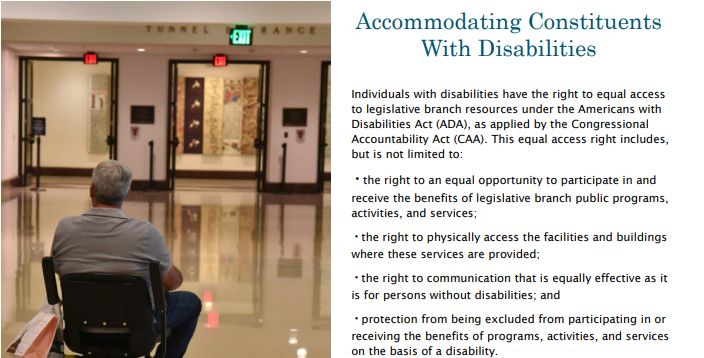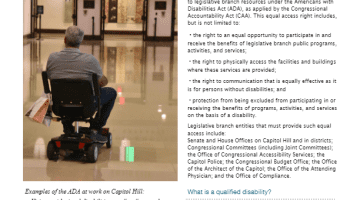Individuals with disabilities have the right to equal access to legislative branch resources under the Americans with Disabilities Act (ADA), as applied by the Congressional Accountability Act (CAA). This equal access right includes, but is not limited to:
- the right to an equal opportunity to participate in and receive the benefits of legislative branch public programs, activities, and services;
- the right to physically access the facilities and buildings where these services are provided;
- the right to communication that is equally effective as it is for persons without disabilities; and
- protection from being excluded from participating in or receiving the benefits of programs, activities, and services on the basis of a disability.
Legislative branch entities that must provide such equal access include:
Senate and House Offices on Capitol Hill and in districts; Congressional Committees (including Joint Committees); the Office of Congressional Accessibility Services; the Capitol Police; the Congressional Budget Office; the Office of the Architect of the Capitol; the Office of the Attending Physician; and the Office of Compliance.
Examples of the ADA at work on Capitol Hill:
- Visitors with visual disabilities can “see” rooms by hearing descriptions from specially-trained guides.
- The assisted listening system in the Library of Congress’s Pickford Theater allows amplified sound for both hearing aids and provided headsets.
- Ramps and elevators in Senate and House office buildings make hearing rooms accessible to individuals using wheelchairs.
What is a qualified disability?
A physical or mental impairment that substantially limits a major life activity.
How can legislative branch entities provide equal access?
Providing equal access will often depend on the type of access that is needed and an individual’s specific disability. For example, communication access may be provided by an auxiliary aid or service, such as sign language interpreting.

